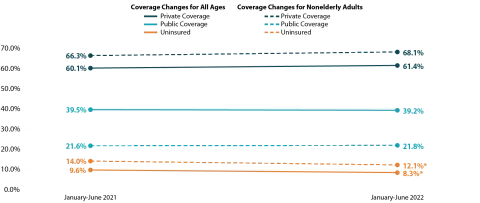As part of the National Health Interview Survey (NHIS) Early Release Program, the National Center for Health Statistics (NCHS) recently published a second round of health insurance coverage estimates for the first half of 2022, covering the months of January to June.
Uninsurance was again measured at historic lows, with just 8.3% of all ages reporting being uninsured compared to 9.6% in the first half of 2021. This significant decrease represents 3.7 million fewer people without insurance through June 2022 (27.4 million as opposed to 31.1 million in 2021).
Other overarching comparisons between January-June estimates in 2022 and 2021 showed:
- The rate of individuals without health insurance coverage was significantly lower among those under 65, particularly for nonelderly adults (age 18-64), who saw a 1.9 percentage-point (PP) drop in their uninsured rate, from 14.0% in 2021 to 12.1% in 2022.
- Rates of public and private coverage remained statistically unchanged for all age groups.
Much like in our analysis of the NHIS Q1 estimates, no measure of statistical significance in either public or private coverage changes was able to account for the large drop in uninsurance rates. Therefore, we can only surmise that the potential shifts in coverage shown by the data—nearly unchanged among public coverage and slight indications of increasing private coverage—may in time point to confirmations of a post-pandemic recovery.
Coverage Changes for All Ages and Nonelderly Adults (18-64)
*Statistically significant at the 95% confidence level.
Important Findings by Demographic Groups
Analyzing coverage rates by more granular population levels revealed few significant changes between January to June of 2022 and the same time in 2021. However, we did note sizeable drops in uninsured rates for nonelderly adults with an income less than 100% of the federal poverty level (down from 19.5% in 2021 to 14.9% in 2022) and nonelderly adults living in states that have not yet expanded Medicaid (decreasing from 17.1% in 2021 to 14.5% in 2022).
While it is heartening to see persistently low overall rates of uninsurance, to anticipate that any perceived gains in private coverage^ have been potentially driven by employer-sponsored insurance and thus by rising post-pandemic employment levels, and improvements in coverage for those experiencing greater levels of poverty, it is also important to understand where there are still opportunities to improve coverage rates. For instance, Hispanic/Latino individuals were more than twice as likely to be uninsured compared with all nonelderly individuals under 65 (20.5% versus 9.9%) for the third year in a row.
Examining uninsured rates for individuals of other races/ethnicities showed that uninsurance decreased to 6.4% from 7.5% between 2022 and 2021 for nonelderly White individuals, but was stable among Black individuals (10.0%), Asian individuals (6.9%), and persons who identified as being of multiple races and other races (8.6%).
Much like overarching national trends, no racial or ethnic groups experienced any significant differences in rates of public coverage; however, White individuals saw gains in private coverage, rising from 72.7% in 2021 to 75.1% in 2022, while Hispanic individuals, Black individuals, Asian individuals, and individuals who reported being of multiple races and other races remained statistically unchanged between the first half of 2021 and 2022, at 44.7%, 49.7%, 72.4%, and 53.2%, respectively.
Impact of COVID-19 on NHIS 2021 Data
While federal survey data collection has recovered greatly from pandemic-related disruptions in 2020, it’s important to note that the presence of COVID-19 did impact collection operations in 2021 to a lesser degree. From January through April 2021, NHIS interviews continued to be attempted by telephone first, with personal visits used only to follow up on nonresponse, deliver recruitment materials, and conduct interviews when telephone numbers were unknown. Starting in May, field representatives were given the discretion to resume personal visits based on their assessment of risks and conditions in the area.
As such, differences between early estimate reports may contain greater variation than in years past; however, all data presented in this report continues to meet NCHS standards of reliability.1
For further details on the impacts of the COVID pandemic on federal surveys in 2020 and 2021, see SHADAC briefs: “Comparing Federal Government Surveys That Count the Uninsured: 2022” and “Changes in Federal Surveys Due to and During COVID-19.”
Notes and Citations
All differences described in this analysis are statistically significant at the 95% confidence level unless otherwise indicated by an “^”.
Estimates are representative of the civilian noninstitutionalized U.S. population, and comparisons presented here are between NHIS data for January-June 2022 and January-June 2021.
1 Cohen, R.A. & Cha, A.E. (December 2022). Health insurance coverage: Early release of estimates from the National Health Interview Survey, January–June 2022. National Center for Health Statistics (NCHS). https://www.cdc.gov/nchs/data/nhis/earlyrelease/insur202212.pdf
National Health Interview Survey Early Release: January-June 2022

